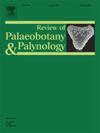New palynological data from Maniamba Basin, Mozambique (Karoo): Correlations and implications for Lopingian floristic ecosystem reconstruction
IF 1.7
3区 地球科学
Q2 PALEONTOLOGY
引用次数: 0
Abstract
Two borehole cores (JOG16N-5 and JOG16N-7) from the Maniamba Basin, northern Mozambique (central Gondwana) were studied for palynology. As a result, five palynoassemblages were identified from JOG16N-5 (T1, T2, T3, T4, T5) whereas only three were identified for the latter borehole (B1, B2 and B3). Palynoasssemblages T1, B1, B2, B3 were assigned to Wuchiapingian whereas the assemblages T2, T2, T3, T4 and T5 were are assigned to Changhsingian.
The age was assigned based on the common occurrence of Lopingian taxa (e.g., Guttulapollenites, Alisporites, Weylandites, Cycadopites, Marsupipollenites, Scheuringipollenites, Protohaploxypinus, and Striatopodocarpites) together with abundant occurrence of stratigraphically important taxa, Thymospora pseudothiessenii as well as Osmundacidites senectus. Typical Gondwana vegetation is observed in both cores and is characterised by dominance of pollen grains assigned to the Protohaploxypinus and Striatopodocarpites genera whereas the monosaccate pollen indicators of upland vegetation are rare. Palynomorph indicators of a lowland setting are common and include Ginkgoales, Filicopsida, sphenopsids, and lycopsids that can be interpreted as the existence of a vast lowland fluvial setting together with floodplains and wetlands in the Basin. Yet, variations in lithofacies indicate a change in the dynamic of the drainage system that prevailed during the Lopingian in the Maniamba Basin. Furthermore, similar palynoevents in Lopingian northern Karoo-aged basins of south-central Africa, and central Gondwana basins from Madagascar, India, and Antarctica are well correlated. However, in contrast, some distinct Lopingian palynoevents are observed with southern Karoo-aged basins which could suggest the existence of tectonic barriers that prevented floral exchange thus, confirming intra-Gondwanan floristic provincialism.
莫桑比克Maniamba盆地孢粉学新资料:Lopingian区系生态系统重建的相关性及其意义
对莫桑比克北部(Gondwana中部)Maniamba盆地两个钻孔岩心(JOG16N-5和JOG16N-7)进行了孢粉学研究。结果表明,JOG16N-5井共鉴定出5个孢粉组合(T1、T2、T3、T4、T5),而后者井只鉴定出3个孢粉组合(B1、B2和B3)。孢粉组合T1、B1、B2、B3属于五家坪县,组合T2、T2、T3、T4和T5属于长兴县。根据Lopingian分类群Guttulapollenites、Alisporites、Weylandites、Cycadopites、Marsupipollenites、Scheuringipollenites、Protohaploxypinus和Striatopodocarpites的常见分布,以及大量具有重要地层意义的分类群Thymospora pseudothiessenii和Osmundacidites senectus的分布,确定了Lopingian的年龄。在两个岩心中均观察到典型的冈瓦纳植被,其特征是花粉粒主要属于Protohaploxypinus和Striatopodocarpites属,而山地植被的单糖花粉指标很少。低地环境的形态指标是常见的,包括银杏科、菲利科、蝶科和石松科,它们可以被解释为盆地中存在一个巨大的低地河流环境,以及洪泛平原和湿地。然而,岩相的变化表明了马尼安巴盆地洛平期占优势的排水系统动力的变化。此外,非洲中南部Lopingian北部karoo -age盆地与马达加斯加、印度和南极洲的Gondwana中部盆地的类似孢粉事件具有很好的相关性。然而,与此相反,在南卡鲁时代的盆地中观察到一些明显的洛平纪孢粉事件,这可能表明存在阻止植物交换的构造障碍,从而证实了冈瓦纳内部植物区系的局限性。
本文章由计算机程序翻译,如有差异,请以英文原文为准。
求助全文
约1分钟内获得全文
求助全文
来源期刊
CiteScore
3.50
自引率
21.10%
发文量
149
审稿时长
6 months
期刊介绍:
The Review of Palaeobotany and Palynology is an international journal for articles in all fields of palaeobotany and palynology dealing with all groups, ranging from marine palynomorphs to higher land plants. Original contributions and comprehensive review papers should appeal to an international audience. Typical topics include but are not restricted to systematics, evolution, palaeobiology, palaeoecology, biostratigraphy, biochronology, palaeoclimatology, paleogeography, taphonomy, palaeoenvironmental reconstructions, vegetation history, and practical applications of palaeobotany and palynology, e.g. in coal and petroleum geology and archaeology. The journal especially encourages the publication of articles in which palaeobotany and palynology are applied for solving fundamental geological and biological problems as well as innovative and interdisciplinary approaches.

 求助内容:
求助内容: 应助结果提醒方式:
应助结果提醒方式:


